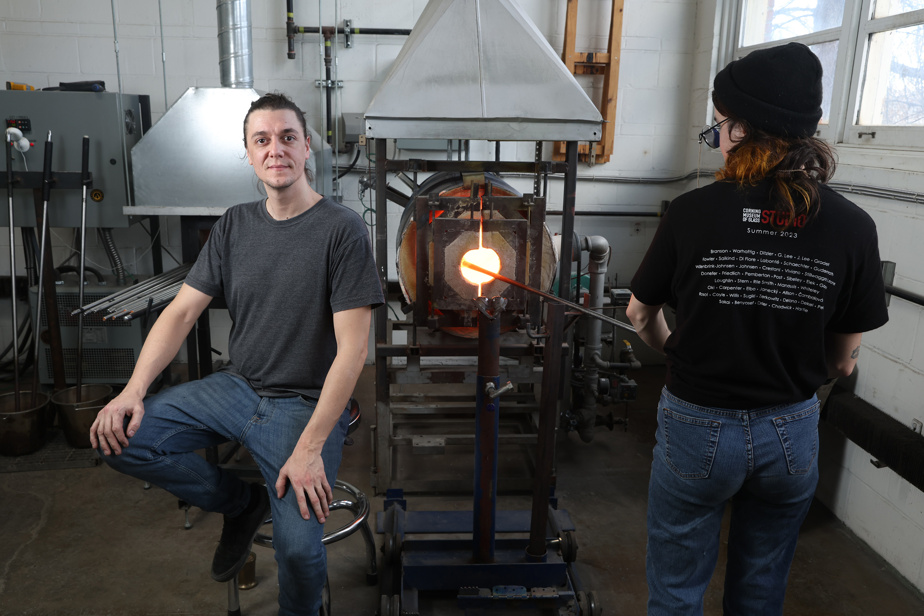Until February 4, you can admire the latest blown glasses by David Frigon-Lavoie in the Galerie de la Guilde (1356, rue Sherbrooke Ouest). Delicate, harmonious pieces that have a story to tell. Like this glass artist who had a passion for blown glass in 2008 at the Cégep du Vieux Montréal.
Having learned the trade at CEGEP, at the Espace Verre workshop school and in the Welmo workshops, in Frelighsburg, or Feu Verre, in Mont-Saint-Hilaire, he benefited from the knowledge of glass artists such as Michèle Lapointe, Patrick Primeau, Julien Mongeau or Michel Leclerc. He began by creating glasses, pints, pots, bottles, oil cruets, then alternating between art and commerce. You have to live well!
“It’s a learning profession,” he says. Before, you were apprenticed for 30 years to a master and then you took over from him. Today, everything goes faster. Since I have been in Bedford, I have let go of my external collaborations to devote myself to my projects. But all the collaborations were necessary to inspire me with the different methods that exist in glass blowing. »
The technique at the source of his creations is called incalmo. This is an old Italian process which consists of hot grafting glass objects by joining two or more elements of different colors before blowing the resulting piece again. A process that produces splendid and unique results.
In his first years of creation, around 2013, David Frigon-Lavoie created sculptures where glass is associated with enamels and metal. Like his work Urban Landscape. From this period, it has retained its themes of ancient architecture and disused buildings. He is particularly passionate about the small water towers that we still see on old buildings in Montreal. He engraves them on his bowls, just like forest landscapes which testify to his love of nature.
Aesthetic, his works are as much contemplative as they are cynical or critical. “I like to add a little social or environmental nod without it being at the forefront,” he says. For my series exhibited at the Guild, Passenger Side, I added new symbols such as electricity pylons. »
For two and a half years, David Frigon-Lavoie has shared a workshop with glass blower Catherine Labonté, in the former sewing machine needle factory in Bedford. He shares the location and the equipment, especially the ovens, a big investment. Each oven has its purpose and its temperature. Very high to melt the glass, a little lower to work it and even less to stabilize it.
He and Catherine Labonté bring their drinks from Sweden. Pallets of granulated glass are placed in a corner of the workshop. “We buy two years’ worth of production,” he says. Four tons of glass can cost over $20,000 USD! »
In a blow molding workshop, two people are required for handling. The 34-year-old artist has added an assistant, Dorothée Bouliane, who followed the same path as him at CEGEP and at Espace Verre. We witnessed the creation of a blown glass bowl.
When we met them, David and Dorothée were preparing to create Christmas baubles for a special order. Balls with a “pineapple” surface obtained after putting the glass in a mold.
David Frigon-Lavoie was a glassworker for 10 years. He considers himself as much a craftsman as an artist. “In Quebec, it seems like it’s pejorative to be an artisan even though it’s noble. It’s knowing your stuff, doing what you do best and showing it. We are always placed in the crafts and not in the visual arts, even though we do them. »
Proud of his first solo at the Guild and of having won the François-Houdé prize (named after the artist co-founder of Espace Verre, who died in 1993), David Frigon-Lavoie appreciates the recognition he enjoys.
A professor at Espace Verre since 2020, he is creating an online site to sell his works, having only one site for his utility objects. “My dream is also to have my workshop in Montreal and to do more exhibitions,” he says. But I want to take it step by step to integrate, at some point, the visual arts community. »
